Credit all goes to http://www.gsmarena.com/ Check out their website it has some GREAT stuff! So what are you waiting for GO GO GO!
Introduction
A lot of people are wondering which iPhone is the right one for them - both people looking to upgrade their own one and people who are just joining the Apple phone party. How much more do you get with the 4S, over the iPhone 4? If you're wondering just that, we're here to help by putting the two head to head.
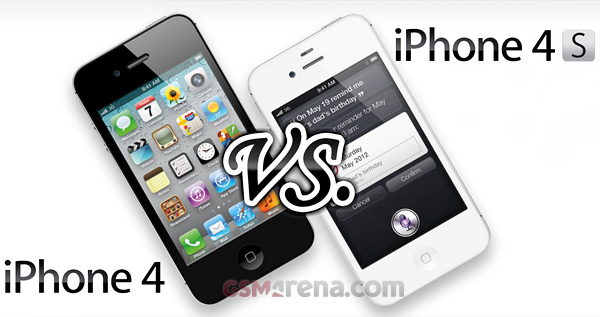
Apple seems to have adopted a Tick-Tock strategy. The 3GS improved on the 3G, but wasn’t a completely new design, that came with the iPhone 4. And now the iPhone 4S improves on the previous model, again without being a complete redesign.
It's a strategy that works, the previous generation of iPhone well proved that. But are the changes enough to justify an upgrade? Some people were underwhelmed when they heard there's no "iPhone 5", while others cheered when they saw Siri and the beefier hardware.
Here's the short list of changes that say "Yes, it's worth it!" and also a few things that could potentially discourage you from upgrading to the iPhone 4S:.
Reasons to buy iPhone 4S:
- Dual-core processor and 7x more powerful GPU
- Siri natural language commands and dictation engine
- 8MP camera with improved low-light performance and capture speed
- 1080p video capture with stabilization
- GSM/CDMA dual-mode device
- No more death grip thanks to dual antenna design
- 64GB option
- Power-efficient Bluetooth 4.0 connectivity
Reasons to stay with iPhone 4:
- Same design
- Same screen too, both in terms of size and resolution
- The amount of RAM is the same
- Siri doesn't work too well for people outside the US
- You'll manage to snap more photos and longer videos and avoid 1080p playback problems
This isn't an in-depth review of the iPhone 4S - there will be a separate article for that. Here, we focus on the differences between the 4S and the iPhone 4.
It's for people who are pondering an upgrade from the 4 to the 4S and for people who have an iPhone 4 and are considering whether or not to wait for the iPhone 5. It's for people buying their first iPhone too (get the cheaper iPhone 4 or the newer 4S?).
We know most people who will be getting the iPhone 4S are current iPhone users, so a straight forward review would be no good for them. This is why we're focusing on the differences between it and the iPhone 4, rather than describing details they are well familiar with, which wouldn't be very helpful with the upgrade or not question.
Let's start with the hardware - not a lot of changes at first glance, but there are still very important hardware changes. We'll be looking at the camera too, the performance and Siri.
Hardware changes
Apple decided to go with the same screen as the previous iPhone - which is to say, one of the best screens on the market. The one thing that could have improved it was if Apple bumped up the size, a move that many expected (even hoped for) but didn’t come.
On the up side, the iPhone experience remains unchanged - in how the UI and apps look, how it fits in your hand and pocket, the compatibility with most accessories.
Speaking of which, we know of one accessory that is no longer needed - the bumper (you can still use one, but for purely aesthetic reasons). Apple learned its lesson from the iPhone 4 and while the iPhone 4S looks practically the same, it features two antennas to combat the "death grip" issue.
Note that we're not talking about one GSM and one CDMA antenna - yes, the 4S is a dual-mode device that supports both networks, but it features two separate antennas that are connected to both radios.
The phone can intelligently switch between the two antennas as needed (even in the middle of a call), so if one antenna is blocked, the other takes over. This means no death grip, no matter how you hold the iPhone 4.
This will improve reception in areas of spotty coverage, where even the slightest sign of death grip can push reception below the threshold needed to make a call. Whether it will improve reception while not holding the phone at all is another question that will take a while to answer - but user reports have been positive for now.
Incompatibilities with accessories stem from the slightly offset mute button. Now the CDMA iPhone 4 has had this design change from day one, so if you are on Verizon US, your bumpers will probably fit quite all.
Clever antenna design aside, the internals of the iPhone 4S were updated too. The Apple A5 chipset features a dual-core processor with PowerVR SGX543MP2 graphics that promise a 7x increase in rendering power.
It's basically the same setup found in the iPad 2. We'll be testing performance later on.
One thing that didn’t change from the iPhone 4 is the amount of RAM - it's 512MB again. We haven't seen iOS having any RAM issues, so we don't think this will be a big deal. The dual-core CPU launches apps tangibly faster, though it's not that big of an improvement. .
The battery in the iPhone 4S has virtually the same capacity as the one in the iPhone 4 save for a few mAh. We're working on a battery test, but that will take a while to complete.
The iPhone 4S camera comes with a wider f/2.4 lens aperture, which will let more light in for its 8MP camera. The sensor design has changed too, both of which should offer improved low-light performance - we'll investigate how much a little later.
Two last changes - the iPhone 4S is available in white from the get go and there is a 64GB version.
We don't think Apple will ever let a memory card get inside their iPhones, but 64GB is about the maximum most phones can offer, even with rare (and pricy) 64GB microSDXC cards. But they do charge a premium for that sort of storage.
Software: hi, Siri
As you've undoubtedly heard (and seen) Siri, the personal digital assistant that lives in the iPhone 4S, is really amazing. It listens to your spoken questions and answers back in its own voice.
It's very flexible and you can ask it for information (weather, stocks, points of interest, you name it) and also ask it to perform tasks for you - set an alarm, add a calendar entry, compose a message, put down a note.
Apple even gave it a bit of an attitude, so when you ask it something silly (as you surely will, just for the fun of it), Siri comes back with a clever answer and a grin on its face. The practical value of such jokes is zero, but it really gives the user a sense that they are speaking to something intelligent rather than something that knows some answers by rote.
You should keep in mind that Siri loses a good deal of its usability outside the US as it can't search for nearby points of interests and businesses. It also supports a limited number of languages and if you think your English will cut it, you may be wrong as Siri is very bad with accents.
Here's the bad news for iPhone 4 owners - Siri is not for you, just for the new iPhone 4S. Now, Apple says the service is in beta, so there's a chance that Siri will come to the iPhone 4 with an update somewhere down the line.
But that's not a given and even if it does happen, you'll have to wait for it. If you want the futuristic convenience that Siri offers now, you'll need an iPhone 4S.
Well, not quite. You can grab a free third party solution (e.g. Vlingo), which covers some of the same functionality and run it on your iPhone 4. Such solutions are not nearly as extensive or as flexible as Siri is, but do give them a try to see if they can be used as a stopgap measure.
The dual-core CPU in the Apple A5 chipset a speeds up the general operation of the iPhone somewhat, but not as much as Apple would have you believe. Very often, the iPhone 4 is neck and neck with its successor.
Here's a comparison video that shows the iPhone 4 and the iPhone 4S launching the same apps, including the camera, and running the same tests side by side:.
Of course, there are other software advancements besides Siri, plus services like iCloud, that launch with iOS 5. They aren't exclusive to the iPhone 4S however. For more details on those, check out ouriOS 5 review.
Still camera: iPhone 4 vs. iPhone 4S
So, the new camera module with a higher-res sensor, that's more sensitive to light and the improved optics let more light in. This should hopefully result in improved overall performance both in good and low lighting conditions, despite the increase in megapixels.
We'll do a more thorough check up of the camera in the review and we'll be doing an in-depth shootout in a separate article. For now, we'll pit the iPhone 4S against the old iPhone 4 to see if it's a worthy upgrade.
And a quick comparison of how both do when the lighting conditions aren’t favorable. Thanks to the bigger aperture, the iPhone 4S uses a lower ISO in the dark and its photos have considerably less noise.
For a quick discussion of the difference in the cameras, we've prepared these crops to highlight our points. They are cropped from photos taken with both the iPhone 4 and the 4S, with the middle section showing what an iPhone 4 photo looks when it's scaled to 8MP.
Have a look at the crops first, we don't want to bias you. Here's what we think - there's less noise in iPhone 4S photos, despite the increased resolution (usually more resolution means more noise too).
You gain a great deal of more detail with the 4S and its dynamic range is wider, so the objects in the shadow come out looking much better. Also, the iPhone 4 seems to exaggerate colors, where the 4S is much more accurate.
Video capture: from 720p to FullHD
The iPhone 4S also goes for FullHD video capture, leaving the iPhone 4 behind in 720p land. The difference between 1080p and 720p is nearly double the pixels - we have some crops from still frames taken out of videos to demonstrate that.
Again, study the crops first. See it? Where the iPhone 4 completely lost all details in the bright area, the 4S preserved some, while the exposures look the same. That comes to show the increased dynamic range of the iPhone 4S camera.
You'll also notice less noise in the iPhone 4S video and more realistic colors (the iPhone 4 boosts the saturation artificially).
Take a look at the middle crop, which is from an iPhone 4 video upscaled to FullHD (which is what will inevitably happen when you watch them on a FullHD TV). The foliage is completely smudged, while you can make out leaves in the iPhone 4S video and the bars of the fence are nice and crisp.
We shot a video with both phones simultaneously and put the result side by side. There's a little zoom window that shows details in the flags too.
One thing we should mention here is just how fast the iPhone 4S camera is - startup times and shot-to-shot times are noticably shorter than on the iPhone 4. The iPhone 4S is one of the quickest shooters around, which will encourage people to take more photos instead of worrying if they'll miss the moment while the camera prepares for the next photo.
Another thing we appreciated was the AF/AE lock - basically, once the phone finds the appropriate focus and exposition settings, they are locked for the entire duration of the video. It's an iOS 5 thing, however, and not an iPhone 4S exclusive.
That's not all - the faster processor in the iPhone 4S has allowed Apple to enable real-time stabilization. We did a quick test of the video stabilization - check out the side-by-side video:.
The two videos were shot with an iPhone 4 and a 4S, both fixed to the same stand held in the hand, so each gets shaken equally. The stabilization does an impressive job, considering it's in real time. Note that it may introduce some geometric distortion though.
This way if you pan between brighter and darker areas or an object fills a lot of the frame and then moves out, there would be no sudden changes in focus and exposition (which can be really annoying in some videos).
Benchmarks: is it twice as fast?
The answer is that very often that's just the case. In browsing, it leaves all other smartphones in the dust. There's the occasional tablet that can come close but that's it. In 3D gaming, it breezes past top-end Androids.
According to the Geekbench suite, the iPhone 4S outperforms the iPhone 4 by a pretty wide margin. When it comes to multithreaded tests, the 4S does actually perform twice as good.
The iPad 2 (which uses the same chipset) scores higher because it seems to run on a higher clock speed. Apple wouldn’t give exact numbers, but here's what the results show.
In single threaded loads, the iPhone 4S has a small advantage over the iPhone 4, but is behind the iPad 2. Still, when it comes to multithreaded tests, the 4S is a lot closer to the iPad 2.

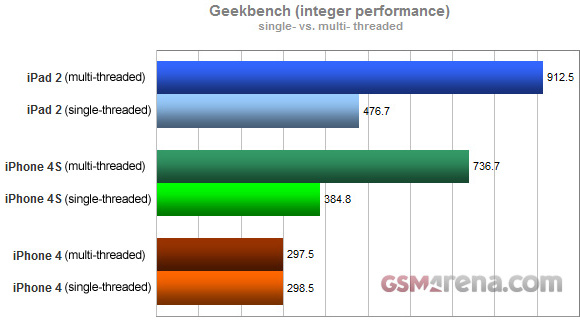
Moving on to 3D performance, the GLBenchmark runs on both iOS and Android, which makes it a good common ground for comparison. We're comparing the "offscreen 720p" results, meaning the graphics were rendered in a 720p frame buffer, regardless of the actual screen's resolution - that puts all devices on even ground.
The iPad 2 has the lead, but when you compare the 4S with smartphones rather than tablets, it's scary fast - the Samsung Galaxy S II has one of the most powerful GPUs in the Android world and it's quite a bit behind the 4S. The iPhone 4 just can't compete - Apple delivered the 7x improvement in graphics they promised.
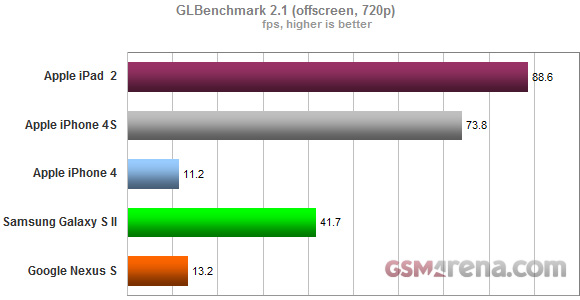
The browser is another area where the iPhone 4S excels. Results for both raw JavaScript performance (SunSpider) and the JavaScript + HTML performance (BrowserMark) are through the roof, with Android dual-cores lagging behind. We'll chalk that up to Apple's software genius, as the CPU alone can't account for the performance gap we're seeing.
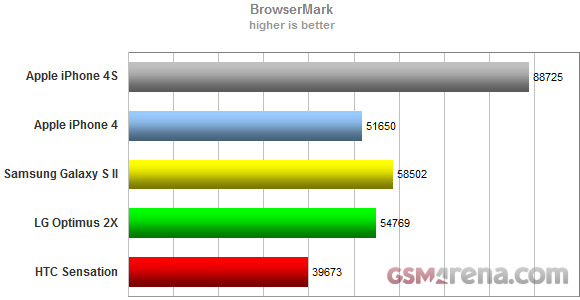
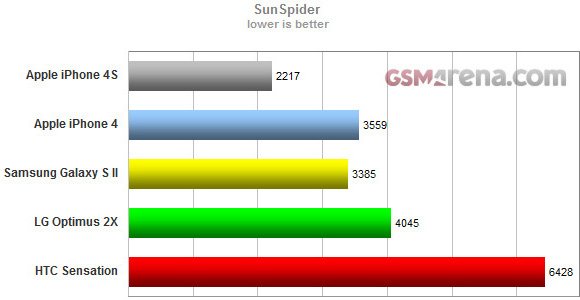
To upgrade or not - our advice
Either your contract is up or you prefer having the latest and greatest from Apple - either way, you're wondering if getting the iPhone 4S is a smart move or whether the iPhone 4 is the better deal.
People who are upgrading from an iPhone 3GS or earlier or don't have an iPhone at all but want one should skip over the iPhone 4 and go straight for the 4S. The $100 you'll save are not worth it in the long run.
But what if you have an iPhone 4 in your pocket right now? Well, if that was your primary camera so far then getting the iPhone 4S is a worthy upgrade. As long as you're fine with using twice as much memory for the same number of photos and videos you shot before since you can't switch to a lower resolution. Some computers might choke on the FullHD video too, which is another potential headache.
Siri is cool, we saw that for ourselves. But it's usefulness is greatly diminished outside the US due to two things - it refuses to search for businesses outside the US and very few languages are supported. Your English needs to be spot on too, accents don't go very well with Siri. Still, for US citizens Siri is all sorts of cool (if you're not shy about talking to your phone that is).
One more thing that can make the upgrade a no-brainer is if you've been having reception issues with the iPhone 4 - there will be none of that with the 4S.
So, here's the final verdict - iPhone owners in the US will have to make a few concessions (not many, really) but getting the iPhone 4S is a smart move. For everyone else, it's less clear cut but an upgrade is still encouraged if you can afford it.
 12:11
12:11
 What Gadgets
What Gadgets

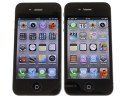
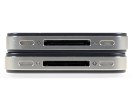
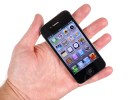
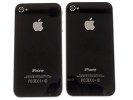
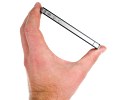
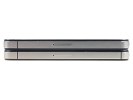

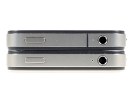
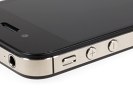
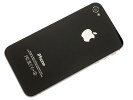
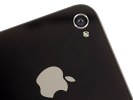












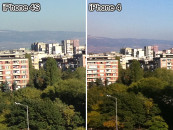










0 comments:
Post a Comment